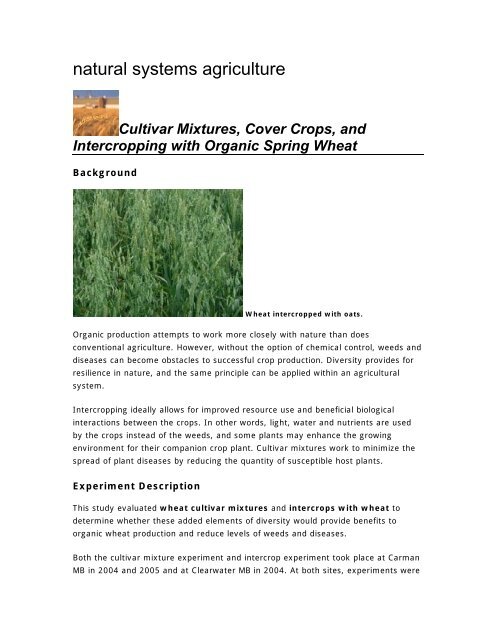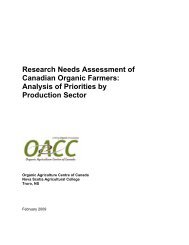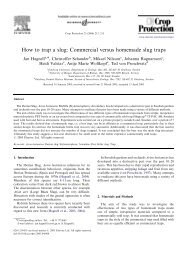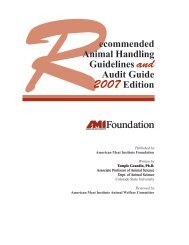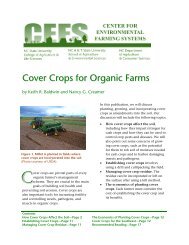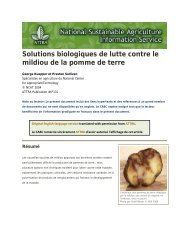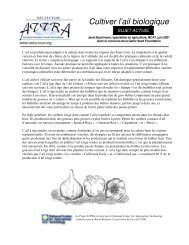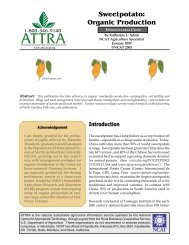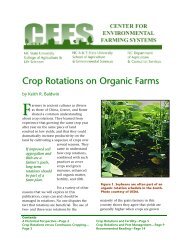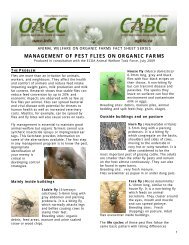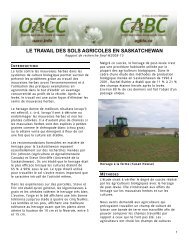Cultivar Mixtures, Cover Crops, and Intercropping with Organic ...
Cultivar Mixtures, Cover Crops, and Intercropping with Organic ...
Cultivar Mixtures, Cover Crops, and Intercropping with Organic ...
Create successful ePaper yourself
Turn your PDF publications into a flip-book with our unique Google optimized e-Paper software.
natural systems agriculture<strong>Cultivar</strong> <strong>Mixtures</strong>, <strong>Cover</strong> <strong>Crops</strong>, <strong>and</strong><strong>Intercropping</strong> <strong>with</strong> <strong>Organic</strong> Spring WheatBackgroundWheat intercropped <strong>with</strong> oats.<strong>Organic</strong> production attempts to work more closely <strong>with</strong> nature than doesconventional agriculture. However, <strong>with</strong>out the option of chemical control, weeds <strong>and</strong>diseases can become obstacles to successful crop production. Diversity provides forresilience in nature, <strong>and</strong> the same principle can be applied <strong>with</strong>in an agriculturalsystem.<strong>Intercropping</strong> ideally allows for improved resource use <strong>and</strong> beneficial biologicalinteractions between the crops. In other words, light, water <strong>and</strong> nutrients are usedby the crops instead of the weeds, <strong>and</strong> some plants may enhance the growingenvironment for their companion crop plant. <strong>Cultivar</strong> mixtures work to minimize thespread of plant diseases by reducing the quantity of susceptible host plants.Experiment DescriptionThis study evaluated wheat cultivar mixtures <strong>and</strong> intercrops <strong>with</strong> wheat todetermine whether these added elements of diversity would provide benefits toorganic wheat production <strong>and</strong> reduce levels of weeds <strong>and</strong> diseases.Both the cultivar mixture experiment <strong>and</strong> intercrop experiment took place at CarmanMB in 2004 <strong>and</strong> 2005 <strong>and</strong> at Clearwater MB in 2004. At both sites, experiments were
managed organically. The Clearwater site had a history of organic production, whilethe Carman site had been managed conventionally prior to these experiments.Measurements in both trials included crop <strong>and</strong> weed biomass, disease levels, <strong>and</strong>grain yield.The <strong>Cultivar</strong> Mixture TrialAC Barrie on the left <strong>and</strong> a mix of Red Fife, Marquis, <strong>and</strong> 5602HR on the right.The cultivar mixture trial implemented 4 varieties of wheat in various mixtures: ACBarrie <strong>and</strong> 5602HR are modern cultivars of Canada Western Red spring wheat;Red Fife <strong>and</strong> Marquis are heritage varieties that are no longer registered <strong>with</strong> theCanadian Grain Commission. Treatments in this experiment included each varietygrown alone, all possible combinations of two <strong>and</strong> three varieties together as well asall four varieties together. Varieties were mixed together to obtain equal proportionsof each variety in the mix, <strong>with</strong> a total seed population of 300 viable seeds persquare metre.The Intercrop TrialThe intercrop trial included three systems <strong>with</strong>in the experiment:1. Wheat <strong>and</strong> other cereal mixtures - wheat <strong>and</strong> oats, wheat <strong>and</strong> barley, <strong>and</strong>wheat <strong>and</strong> spring rye2. Wheat <strong>and</strong> other seed intercrop mixtures - wheat <strong>and</strong> flax, wheat <strong>and</strong>field pea, <strong>and</strong> wheat <strong>and</strong> oriental mustard3. Wheat <strong>and</strong> cover crops - wheat <strong>and</strong> red clover, wheat <strong>and</strong> hairy vetch, <strong>and</strong>wheat <strong>and</strong> annual ryegrass.In all these systems, wheat was seeded at half the normal seeding rate (150seeds/m 2 ). The intercrops were also seeded at half the normal seeding rates, exceptfor flax which was seeded at the full rate. Intercrops were compared to monoculture
wheat planted at a full seeding rate (300 seeds/m 2 ) <strong>and</strong> at a half seeding rate (150seeds/m 2 ).Economic analyses were carried out on the intercrop trial to see which mixtureswould be most profitable for producers. Net returns for each system were calculatedusing the Guidelines for Estimating 2005 Crop Production Costs set out by ManitobaAgriculture, Food <strong>and</strong> Rural Initiatives, excluding herbicide <strong>and</strong> fertilizer costs, butincluding a seed cleaning cost for separation of intercrops <strong>and</strong> using organic marketprices for grains.ResultsThe <strong>Cultivar</strong> Mixture TrialWheat cultivar mixtures provided yield stability <strong>and</strong> resulted in lower disease levelsthan some varieties of monocropped wheat in this experiment.Disease IncidenceOf the four varieties tested, AC Barrie <strong>and</strong> Marquis were found to be mostsusceptible to disease (rusts, tan spot), while Red Fife had the lowest diseaseincidence. Red Fife's resistance to disease was attributed to its slower development(later heading). It was interesting to observe that the mixtures including Red Fifealso had low disease levels, even when other varieties in the mix were highlysusceptible to disease. The modern cultivar 5602HR had good resistance to rust butwas susceptible to tan spot.Wheat YieldIn general, wheat grain yield did not vary greatly between treatments. Heritagevarieties had comparable grain yields to the modern varieties, suggesting that underorganic management, heritage varieties (specifically Red Fife) are competitiveenough to produce yields similar to modern varieties that are bred for a high harvestindex. The modern variety 5602HR also performed well in general in this experiment,<strong>and</strong> out-performed other varieties <strong>and</strong> mixtures at Carman in 2005 where plots wereflooded due to excess rainfall.Variety mixtures generally outyielded AC Barrie <strong>and</strong> Marquis grown as monocrops<strong>and</strong> were comparable to Red Fife <strong>and</strong> 5602HR. As AC Barrie <strong>and</strong> Marquis sufferedhigh disease incidence, it is not surprising that their yield was reduced.
Considerations for Implementing <strong>Cultivar</strong> <strong>Mixtures</strong> of WheatEven though cultivar mixtures including heritage wheat varieties may offeragronomic advantages, there are other considerations that affect the feasibility ofimplementing such mixtures on organic farms.Since Red Fife <strong>and</strong> Marquis are not registered <strong>with</strong> the Canadian Grain Commission,the marketability of these varieties is limited. However, Red Fife is gainingrecognition through the Slow Food Movement <strong>and</strong> is in high dem<strong>and</strong> from artisanbakers; therefore direct marketing of Red Fife may prove to be worthwhile.Marketing cultivar mixtures of registered varieties would not be problematic, butmixtures containing non-registered varieties would need to be marketed directly tobuyers. A cultivar mixture would not have the same niche market appeal as pure RedFife, <strong>and</strong> thus the marketability of these mixtures may be severely limited.The Intercrop Trial<strong>Intercropping</strong> wheat <strong>with</strong> other cereals, other grain crops, <strong>and</strong> cover crops resultedin varying effects on weed suppression, disease levels, grain yield <strong>and</strong> the economicsof the systems.Weeds <strong>and</strong> DiseasesIn general, intercrops that developed a full canopy <strong>and</strong>/or competed <strong>with</strong> a majorweed for resources caused a certain amount of weed suppression. In thisexperiment, oat, barley <strong>and</strong> flax intercrops <strong>and</strong> the annual rye cover crop resulted inlower weed biomass in some site-years. However, these intercrops also suppressedwheat growth by competing for resources <strong>with</strong> the wheat crop. This was especiallytrue of the flax crop, which was seeded at the full recommended seeding rate.Wheat intercropped <strong>with</strong> field pea.
The levels of foliar wheat disease were often reduced when wheat was grown <strong>with</strong>intercrops. Wheat grown <strong>with</strong> field pea had consistently lower disease levels,probably due to the physical barrier created by the pea vines. Flax also reduceddisease levels in wheat (only measured at Carman in 2005).Although the intercrops tested in this experiment offered some weed <strong>and</strong> diseasesuppression in certain cases, it seemed to be difficult to suppress both weeds <strong>and</strong>diseases <strong>with</strong> the same intercropping system. Those intercrops that tended to haveless weed growth had higher incidence of disease, <strong>and</strong> those that had lower diseaselevels did not suppress weeds.Grain YieldGrain yield was measured both in terms of wheat yield <strong>and</strong> total grain yield includingthe intercrop (not the cover crop yield, however). As expected, the full-rate wheatconsistently had the highest wheat yield of all the treatments.Wheat <strong>with</strong> hairy vetch cover crop.Flax, oats, barley <strong>and</strong> spring rye competed aggressively <strong>with</strong> wheat, <strong>and</strong> tended toreduce wheat yield to less than the yield of half-rate wheat. However, when the grainyield of the intercrop was taken into account, the cereal intercrop systems (oats,barley, spring rye) performed quite well, <strong>with</strong> total yields often similar to or greaterthan the yield of full-rate wheat.Wheat intercropped <strong>with</strong> field pea, oriental mustard, <strong>and</strong> the cover crops hadvariable results. For example, hairy vetch totally overwhelmed the wheat crop in2005, but resulted in yields similar to half-rate wheat at both sites in 2004. Thisdemonstrates the importance of environmental conditions in determining the"success" of any particular intercropping system.
EconomicsAlthough grain yield data is important, the feasability of implementing intercroppingsystems depends heavily on the profitability of the system. Table 1 belowdemonstrates the variability in net returns for the intercropping systems tested inthis experiment, ranging from $655/acre to a loss of $82/acre. Full-rate wheat wasamong the most consistently profitable treatments, <strong>and</strong> even half-rate wheat wasmore profitable than many of the intercrop combinations. Wheat-barley <strong>and</strong> wheatspringrye were the more profitable cereal intercrops. The wheat-mustard intercropproved to be among the most profitable combinations, while wheat-flax <strong>and</strong> wheatfieldpea gave inconsistent but potentially promising results.The cover crop treatments tended to have lower returns because the cover crops didnot provide a saleable product, nor did they generally have significant positiveeffects on wheat yield. In fact, the cover crops resulted in negative returns in twocases (see Table 1). However, not included in this analysis are the benefits thatcover crops can provide to the following crop. Legume cover crops in particular canprovide signficant nitrogen contributions to the soil, which are especially important inorganic cropping systems.Table 1. Net returns from intercropping systemsNet Return ($/acre)Treatment Clearwater 2004 Carman 2004 Carman 2005Wheat-oat 72.53 227.34 66.05Wheat-barley - 233.13 191.82Wheat-spring rye 96.98 185.35 122.87Wheat-flax 5.61 315.55 111.00Wheat-field pea 79.67 243.59 66.19Wheat-mustard 136.70 655.29 134.15Wheat-red clover 100.29 156.41 62.84Wheat-hairy vetch 104.74 189.57 -82.08Wheat-annual ryegrass 74.06 124.02 -18.30Half-rate wheat 119.15 194.34 120.81Full-rate wheat 155.56 244.71 156.53Considerations for Implementing <strong>Intercropping</strong> <strong>and</strong> <strong>Cover</strong> Crop SystemsCereal intercropping systems were the highest yielding among those tested in thisexperiment, but they also present the greatest difficulties in separating the wheatfrom the other crop. This may limit the practicality of these systems on organicfarms.
Flax is an important crop in organic systems because of its role in crop rotations aswell as the price premiums available. The wheat-flax intercrop was not particularlysuccessful in this experiment because of the high flax seeding rate; however, at areduced seeding rate, a wheat-flax intercrop could prove to be both practical <strong>and</strong>profitable.Wheat <strong>with</strong> annual ryegrass cover crop.Field pea also showed some potential as an intercrop <strong>with</strong> wheat, offering somedisease suppression <strong>and</strong> fairly good grain yields, as well as contributing nitrogen tothe system (although this was not measured in this experiment). Some shatteringwas observed during field pea harvest, suggesting that harvest should occurpromptly to avoid harvest losses.The wheat-mustard intercrop was very profitable in one case, but was also subject toflea beetle infestations, making this a more risky option for organic farms. However,if producers wish to grow oriental mustard, intercropping the mustard <strong>with</strong> wheatreduces the risk involved, since the wheat can compensate for a mustard cropfailure.Wheat grown <strong>with</strong> a red clover cover crop was moderately successful; however, hairyvetch <strong>and</strong> annual ryegrass competed too aggressively <strong>with</strong> the wheat crop in wetgrowing conditions.
Conclusions <strong>and</strong> Recommendations1. 5602HR is a modern high-yielding wheat variety suited toorganic production.2. Red Fife is a heritage wheat variety suited to organicproduction. Red Fife had low disease incidence <strong>and</strong> is indem<strong>and</strong> from artisan bakers.3. <strong>Cultivar</strong> mixtures can reduce disease incidence but may presentmarketing challenges.4. A cereal intercrop such as wheat-barley can be competitive <strong>and</strong>profitable, but it is difficult to separate the two types of grain.5. For a wheat-flax intercrop, reduced seeding rates should beused for both wheat <strong>and</strong> flax crops. Flax can outcompete wheatif seeded at the full rate.6. A wheat-field pea intercrop can reduce disease <strong>and</strong> contributenitrogen to the system. Wheat-field pea should be harvestedpromptly to avoid shattering.7. Wheat-oriental mustard can be profitable but is also highlysusceptible to flea beetle attack. Do not include mustard inrotation too frequently to avoid flea beetle infestations.8. Red clover appears to be a better cover crop choice than hairyvetch or annual ryegrass. Hairy vetch <strong>and</strong> annual ryegrass canoutcompete the wheat crop, especially in wet conditions.This page created June 2005.Updated December 2006 by Natural Systems Agriculture of the University of ManitobaOACC gratefully acknowledges the University of Manitoba forpermission to reproduce this article on OACC’s websitePosted on OACC website November 2007


